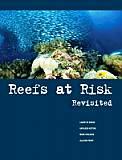
75% of Coral Reefs Threatened, Analysis Finds
The report's authors make multiple recommendations to better protect and manage reefs, including through marine protected areas.
A comprehensive analysis finds that 75 percent of the world’s coral reefs are currently threatened by local and global pressures. The analysis includes threats from climate change, including warming seas and rising ocean acidification, and shows that local pressures — such as overfishing, coastal development, and pollution — pose the most immediate and direct risks, threatening more than 60 percent of coral reefs today, according to the World Resources Institute (WRI).
“Reefs at Risk Revisited” was released by WRI, along with the Nature Conservancy, the WorldFish Center, the International Coral Reef Action Network, Global Coral Reef Monitoring Network, and the UNEP-World Conservation Monitoring Center, along with a network of more than 25 organizations.
“This report serves as a wake-up call for policy-makers, business leaders, ocean managers, and others about the urgent need for greater protection for coral reefs,” said Jane Lubchenco, Ph.D., under secretary of commerce for oceans and atmosphere and NOAA administrator. “As the report makes clear, local and global threats, including climate change, are already having significant impacts on coral reefs, putting the future of these beautiful and valuable ecosystems at risk.”
Local pressures – especially overfishing and destructive fishing – are causing many reefs to be degraded. Global pressures are leading to coral bleaching from rising sea temperatures and increasing ocean acidification from carbon dioxide pollution.
“Coral reefs are valuable resources for millions of people worldwide. Despite the dire situation for many reefs, there is reason for hope,” said Lauretta Burke, senior associate at WRI and a lead author of the report. “Reefs are resilient, and by reducing the local pressures we can buy time as we find global solutions to preserve reefs for future generations.”
The report includes multiple recommendations to better protect and manage reefs, including through marine protected areas. The analysis shows that more than one-quarter of reefs are already encompassed in a range of parks and reserves, more than any other marine habitat. However, only six percent of reefs are in protected areas that are effectively managed.
“Well managed marine protected areas are one of the best tools to safeguard reefs,” said Mark Spalding, senior marine scientist at the Nature Conservancy and a lead author of the report. “At their core, reefs are about people as well as nature: ensuring stable food supplies, promoting recovery from coral bleaching, and acting as a magnet for tourist dollars. We need apply the knowledge we have to shore up existing protected areas, as well as to designate new sites where threats are highest, such as the populous hearts of the Caribbean, Southeast Asia, East Africa and the Middle East.”
According the report, more than 275 million people live in the direct vicinity (30 km/18 miles) of coral reefs. In more than 100 countries and territories, coral reefs protect 150,000 km (over 93,000 miles) of shorelines, helping defend coastal communities and infrastructure against storms and erosion.
For the first time, the report identifies the 27 nations most socially and economically vulnerable to coral reef degradation and loss. Among these, the nine most vulnerable countries are: Haiti, Grenada, Philippines, Comoros, Vanuatu, Tanzania, Kiribati, Fiji, and Indonesia.
Source: World Resources Institute